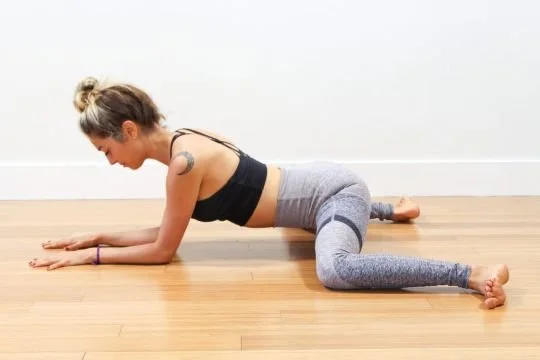Issue #428: Stop Skipping Out on Mobility
Good morning. It’s Tuesday, February 11th.
In today’s email:
Learn: Injury vs. Discomfort
Try: Create a Mobility Routine
In the News: Wellness Pseudoscience
Stat of the Day
The world record, set in 2022, for holding a deep squat - by 22-yr Gabby Rushing in North Little Rock, Arkansas. (Guinness World Records)
Learn
Injury vs. Discomfort
Here’s my ideal weekly workout schedule:
2x HIIT (45 min station class)
2x running, biking or swimming
1x heavy lift
1-2x yoga/mobility
Without fail if my week gets busy the first thing to drop from my workout is always, always yoga or mobility.
Somewhere deep in my brain it doesn’t feel like there’s as much of an ROI compared to getting a real good sweat going.
Or maybe I just dislike it because it’s my weak link - probably because I skip it so frequently.
But this is a HUGE mistake and something I’m actively trying to change in 2025 as I realign my focus on mobility.
The Science
Restricted mobility leads to the inability of doing activities - so we can’t fully live our best life; it lowers our endurance, and it increases our risk for injury.
Our modern life has reduced the different ways we move our body.
When we don’t use our full range of motion, it’s not just our muscles and tissues that become more stiff (although that’s true), our brain doesn’t believe that movement is safe for us anymore and our nervous system “protects us” by stopping that movement.
The CDC says that 12.2 percent of Americans have a mobility disability - which means they can’t walk or live a full life. But there are many more of us that are “mobility challenged.”
Consider the most basic example of raising one arm over your head. Can you do this with a completely straight arm (no bend in your elbow), your shoulders down and perfectly parallel to each other, and without tilting your neck?
If you look in the mirror at how your body is actually moving here, you may find this isn’t as easy as you think - or you might have slight discomfort holding this “easy” pose for any length of time.
This example is one of a lack of mobility.
The reason this is so common is because most of us aren’t fully using the joints, ligaments, tendons and muscles as intended.
Even those of us that consistently work out, we typically do the same movements over and over and don’t counter-balance those movements with positions that make us uncomfortable.
The first thing to do is to just notice - not to judge - where you see and feel a limited range of motion.
Pain is actually the best signal to get our attention. Too often we feel pain and ignore it “well I shouldn’t do that again.”
But this is the wrong reaction. How is something going to get better if we don’t focus on it??
Plus, we just “hope” we can get our mobility or flexibility back. That’s obviously not a strategy and will never work.
It’s about leaning into the discomfort to build back your movement.
If you pull your calf, then the last thing you should do is go run on it tomorrow morning. It needs time to heal to prevent a more severe injury.
But what about discomfort?
I just attended a 2-hour mobility workshop and didn’t realize that it had started when we spent the first 10 minutes sitting cross-legged on the floor with a tall spine. We were just sitting - but wow this was hard on my tight hips.
Almost everyone in the class started fidgeting and moving around to keep close to the intended position. And you know what - that’s a good thing.
By putting our body in safe positions that are natural for us humans - but no longer comfortable for us - we’re re-training our muscles and our nerves so that we can get back our full range of motion.
Target Zone
The key is to identify where you want to improve your range of motion. You might already notice these things - for me it’s my shoulders/posture and tight hips, hamstrings and ankles.
Target 1-2 areas and make it a priority to focus on improving your mobility on these parts of your body.
Thrive25 Partner Spotlight
Kickstart your 2025 healthy routine
Upgrade your day with award-winning DIRTEA Coffee Super Blend. For people seeking sharper focus, a calm mind, and lasting energy:
Over 1,000mg of Lion's Mane per Cup
80% less caffeine than regular coffee
Made with the highest quality Organic Certified ingredients.
Try
Create a Mobility Routine
Start a daily 5-10 minute mobility routine. It can be in the morning when you wake up or before you go to bed - whatever works best for you.
Here’s 3 exercises to consider:
Shoulders & Chest - Slow Arm Circles
Raise up your arm like you’re going to shake someone’s hand and keep going up until it’s in line with your head (keep your shoulder down), then flip your palm out and finish the circle going as slow and as wide as possible. Go for 10x in both arms.
Shoulders - Thumbs Up & Down
Put your arms out wide, parallel to the ground with palms facing forward and thumbs up. Slowly move one arm to thumbs down - WITHOUT rotating your shoulder forward or bending your arm. Move back to thumbs up and switch sides. Work your way to doing thumbs-down with both arms at the same time. Try each movement 10x.
Hips - Frog or Deep Squat
We ended our mobility workshop by holding a “frog pose” for 3 minutes!
With your hands on the ground in front of you, put your inside knees and the inside of your foot on the ground. Basically you’re trying to get as low to the ground as possible. Don’t worry I’m not even close - but working on it.
If that’s too much - you can do a deep squat (catcher’s position) with feet flat on the ground.
Still too much? No judgment here - just sit cross-legged on the floor.
The key is just holding and going past that point of discomfort where you want to quit.
Other ideas: Basic Yoga Flow (upward/downward dog) and the World’s Greatest Stretch.
H&L in the News
Mouth Bacteria and Dementia: The bacteria living on your tongue and gums may affect how our brain works and maybe even if we’ll develop cognitive decline. (ScienceAlert)
Ultrasound Zaps Aging Cells: Scientists are using ultrasound to help the body clear aging cells, potentially reversing skin aging and boosting health. This non-invasive breakthrough could redefine anti-aging treatments. (Lifespan.io)
Wellness or Woo? The Dark Origins: The $5.6T wellness industry thrives on pseudoscience, tracing its roots to early influencers like John Kellogg and Bernarr Macfadden. Discover how their legacy still shapes modern health fads. (Big Think)
Thanks for joining us today!
Want to see what we’re up to? Sign up for early access to our platform
Check out the latest videos on our YouTube channel
Got feedback, recommendations or stories to share? Tell us what’s on your mind here
Want this direct to your inbox? Sign up here
Why Thrive25
We’re 40-something dads that felt our bodies and minds start to slow down and we’re not ready for that. We found too much information on every subject. So we started Thrive25 to transform what we’ve learned into something useful for the rest of us to spend just 3-5 min a day to optimize our health & longevity.
This newsletter is for you and we truly value your feedback. Never hesitate to reach out to us at team@thrive25.com.
To health!
Sign up for free:
The information in this newsletter is for informational purposes only and may not be appropriate or applicable based on your individual circumstances. Thrive25, Inc. does not provide medical, professional, or licensed advice. Please connect with your healthcare professional for medical advice specific to your health needs.







